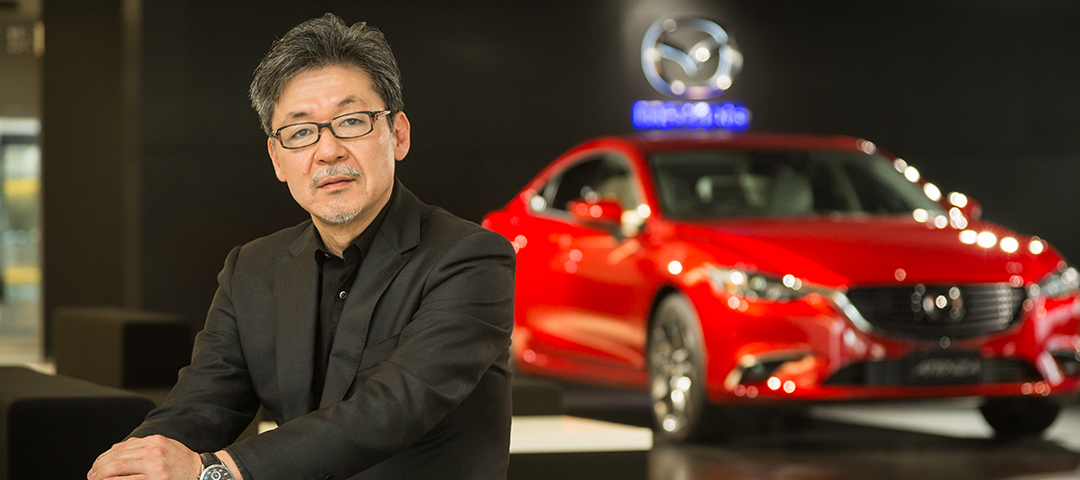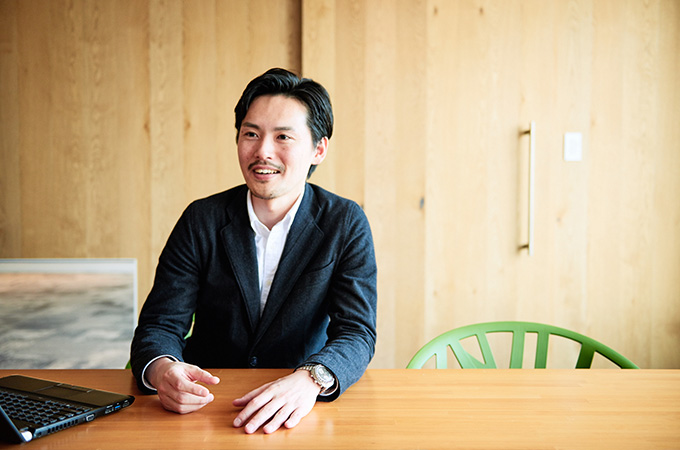Rebuilding Mazda’s Wavering Brand Image with “Life-imbuing Design”
Mr. Maeda, as a car designer, you are now working at the vanguard of your profession. Why did you choose Kyoto Institute of Technology to pursue your study of design?
Maeda: Actually, I was interested in architecture as well as design, so I sat the entrance exam for several universities that had both architecture and industrial design departments. The instant I walked through the gates of Kyoto Institute of Technology, I felt a powerful sense of purpose and individuality. The other, much larger universities I applied to had an air of harshness to them somehow, but being a small school, KIT had a kind of concentrated richness to it. I instinctively felt this was where I wanted to study and decided to enroll. As I studied industrial design in the Design Science and Technology Department, the attraction I had always felt towards car design became even stronger, and after I graduated, I joined Mazda. Following stints at Mazda’s North American design studio and Ford Design, I am now involved in design and development in the Mazda headquarters design studio.
Mazda’s image has undergone a major transformation since you became General Manager of the Design Division in 2009. All the models released since your appointment have been hits, and Mazda is becoming increasingly recognized around the world for its excellence in design. Could you tell us exactly what the job of General Manager of the Design Division entails?
Maeda: Basically, my role as design leader is to pull the team in the direction that Mazda design needs to be heading in. Mazda has a diverse range of models, and my role is to create designs for all of those models from a global perspective. However, starting with my generation, the perspective of “branding” has been added to the job. We not only have to think about the cars, our creations, as products in themselves; we also have to think about the “receptacle” that those creations will be placed in. To achieve this branding, we have started to create total designs, including environments, for dealer showrooms and motor show venues, for example, so the extent of our work has broadened considerably.
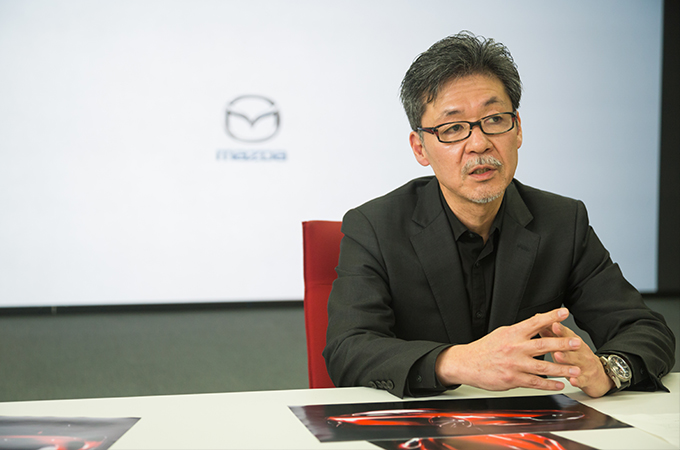
Why did you start to focus on “brand?”
Maeda: Generally in Japan, the word “brand” is considered to be just the brand logo on a product. That is, if a product has a logo on it, then the product belongs to that brand. However, the true meaning of “brand” is, I believe, a style or attitude towards monozukuri or “making things” that is manifested in a company’s products in a uniform way. The old Mazda had not realized this and, as a result, a hit product would be followed by a flop. This was a pattern that kept repeating itself. In other words, even amongst ourselves, our brand image wasn’t stable. This is why I decided that we needed to reconsider it from the initial point of monozukuri, and make sure that the beauty of form that we devised as a result would permeate all of our products, activities, and sites.
What did you do first to achieve that?
Maeda: Mazda does have its own “monozukuri traditions.” We just didn’t have the appropriate words to describe those traditions. We repeatedly debated among ourselves about what “monozukuri” meant to us. What came out of those discussions was the “Soul of Motion” theme that has now become the guidepost of our brand. In other words, design that is not static, that has motion, is what lies at the foundation of Mazda. However, “design with motion” can mean many things. For example, just placing a wave-like graphic on the body of a car can give it a sense of motion, but that would be superficial. That is why we started to become conscious of giving life to our cars, to expressing motion that gives a sense of life.
So, you tried to incorporate the motion of something that is alive – like a living creature?
Maeda: That’s right. One of Mazda’s brand messages is, “We want you to love your car like a member of the family.” In Japanese, we have the word “aisha”, literally “loved car.” I don’t think there is any other industrial product that has the word “loved” attached to it in the same way. I wanted to embody that sense of value that people place in their cars, the way they “love” them just like their family, friends, or lovers. I entrusted that intent in the concept car, Shinari, that I worked on soon after my appointment. For that car, I took reference from animals such as the jaguar and cheetah, which are considered to be the high-speed athletes of the animal world. The beauty of these animals lies in the principles of their motion. I learned a great deal by studying these animals, not just superficial things, but the importance of having a “beautiful bone structure,” for example. I took what I learned and, while continuing the traditions of the company, poured everything that I wanted to do as a designer, and everything that I felt was needed to take our brand to the next level, into Shinari.
This was a very important creation, one that would decide the future direction of the company, wasn’t it?
Maeda: When I look back now, and I am not exaggerating, I staked my very life as a design leader on that creation. Mazda has about 20,000 employees today, and that one car had the potential to propel the livelihoods of all of those people forward. At the same time, it could propel forward the original tradition of the company. Once it was out in the world, there was no turning back. The reaction to it could have been completely different from what I hoped. We presented it at Milan, Italy with great trepidation, but I am happy to say it was well received. I was greatly relieved, and in that instant, my ideas became convictions.
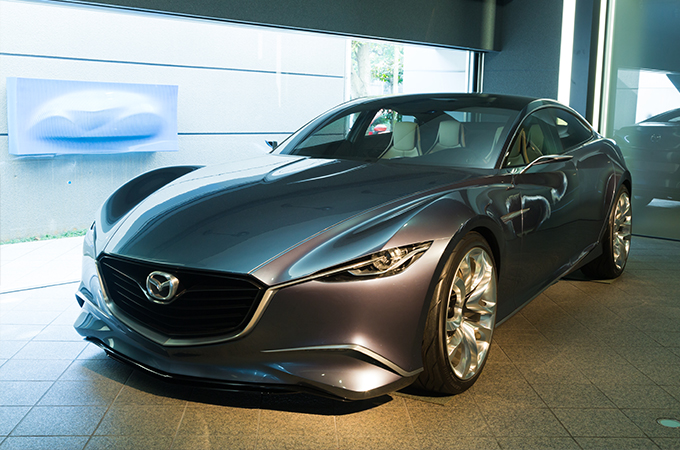
The idea for designing cars as architectural structures came from the traditional culture I encountered while at KIT.
Has your passion and certainty of purpose come from your love of cars?
Maeda: Yes, probably. My love affair with cars started when I was in around 5th or 6th grade of elementary school, when, tightly gripping my pocket money, I went to see the movie, “Le Mans.” It came out in 1971 and featured Steve McQueen in the lead racing car driver role. I remember being struck by the excitement of the race scenes. Back then, it was all filmed as live action, with none of the computer graphics you see today. It was just so cool and it really made a deep impression on me. I have loved cars and motor sports ever since.
Why did your interest turn to the design aspects of cars?
Maeda: I first became more conscious of design when I was in senior high school. At the time, my father had a paper knife that had been designed by Italian designer, Enzo Mari. It had such a simple form, but when I held it in my hand, it fit perfectly and was very easy to use. That made me realize, “This is what design is all about.”
So, you decided to become an industrial designer. When you enrolled at Kyoto Institute of Technology, what about the university first impressed you?
Maeda: I really liked the lack of distance between us and students from other departments. The (then) Faculty of Engineering and Design had a variety of interesting departments, and I gained a lot of stimulation from students studying in other fields, such as living environments and architecture, that had a lot to do with what we were doing. I don’t think that this aspect is common to most art schools. What was particularly good was the fact that it even had a textiles department. This is something that could only happen in a Kyoto university, isn’t it? I really enjoyed becoming familiar with fields that have a direct link to tradition, such as Nishijin-ori weaving.
The kind of stimulation you describe seems to have carried over into your current design work in some ways.
Maeda: Yes, I think it has. I encountered interdepartmental stimuli at KIT, but I also encountered them when I was out and about in Kyoto. For example, on my days off, I would often go to a temple and spend all day sitting on the engawa veranda. What I would see from there was the way the nuances of Japan’s traditional architecture were displayed, and a kind of concentrated dynamism. Also, I also often keenly felt the dignified air of my surroundings. When I am designing a car, I take painstaking care to ensure that it is not flat, that it has three-dimensional form, with depth and nuance. Also, one of the biggest themes that I want to express as a car designer is the seamless, finely honed world that is expressed in Japanese gardens and the like. This is where my experiences as a university student are brought to life.
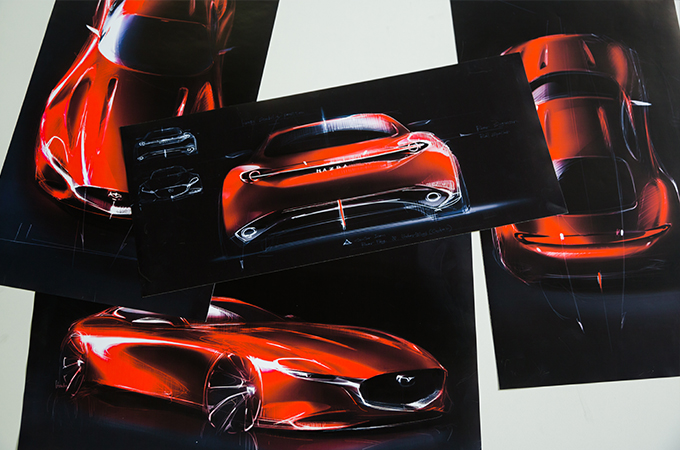
At the beginning of this interview, you mentioned KIT having a “concentrated” ethos due to its small size. Has that flowed over into your current workplace at Mazda?
Maeda: Yes, I think so. Mazda produces 1.5 million vehicles a year, roughly the same as BMW or Audi. However, we consider ourselves a “minor player” and aim to be a strong presence that, though small, shines brightly. We want to make the most of the strengths that come from being a small company and engage in monozukuri with care and consideration. In large companies, marketing cannot help but come first, and they tend to focus on things like how to sell their products and how to increase their market share, but we want to be like the artisans in small, local factories who take great care with each single product that they make. What I felt at Kyoto Institute of Technology was that strong sense of purpose.
Was there anything that you made a habit of doing in terms of your design studies while you were at university?
Maeda: You wouldn’t have described me as a very serious student, but I think you could have observed an overall tenacious attitude toward tackling assignments. We would all go the private study rooms and work really hard on perfecting our assignments, often working all night, right up to the submission deadline. That happened a lot. I would delve deeply into whatever I did. That attitude of continuing with a task with a strong intent is something that I still have in my work today. I do have quite an obstinate personality (laughs) and I think it’s a good thing. When you look at an object, don’t do so in a desultory manner. Always question that object. University students have a lot of free time, so I recommend that they spend a lot of time immersing themselves in something. That should eventually become one of their strengths and stand them in good stead in the future.
During your time at university, what was the thing that you made with the most passion?
Maeda: We had a range of different assignments. One of them was to make a piece of furniture that was also a lighting fixture. I totally immersed myself in that task. It consisted of a very large light and hundreds of small acrylic pieces that I had to piece together by hand. The finished work looked completely different depending on whether the light was switched on or off. When I think back on it now, it was actually a really interesting piece. I was also passionate about driving cars (laughs). Many of my classmates had cars, and we all loved cars and driving. We would go up to the mountain pass to practice, and we even swapped engines and learned a lot about how cars are built. My passion for this kind of thing intensified to the point where I joined an amateur rally club and actually took part in rallies. Quite a few of my classmates, who were equally passionate about cars, went on to work at Mazda and Honda, and big automakers like Toyota and Nissan. Many of them are working as leaders in the design divisions of their companies.
So, you all really loved cars?
Maeda: We had some amazing people in that class. There is nothing to limit you while you are in university, so I think it is very important that you use those years to discover at least one thing that you can be better at than others. In that respect, I think it was quite significant that I learned a lot of things about cars, not just design, while I was at university. If you were to ask me if you can learn everything about realistic car design at university, I would say that it would be difficult under the present circumstances. Some countries overseas have specialist training colleges for car design. In terms of technique, graduates of those kinds of colleges probably have a two-year head-start over Japanese university graduates. Having said that, while honing one’s technique is of course, important, having something above and beyond that can also be a major asset.
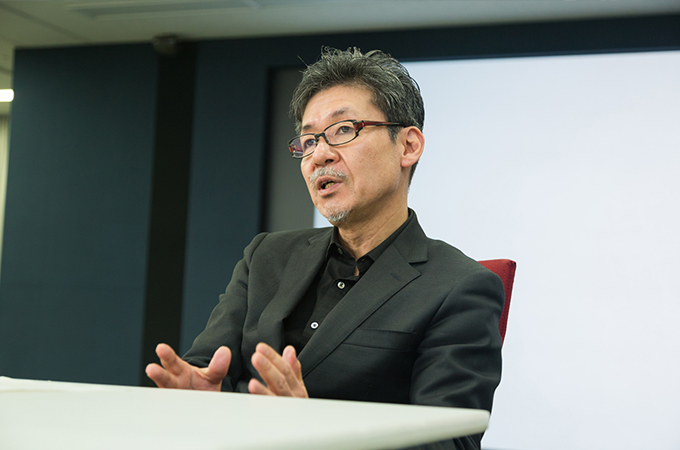
It is important to have convictions that aren’t swayed by others, even if they are immature.
It has become quite common these days for companies to engage in joint research with universities. If you were to do something like that, what would you like to do?
Maeda: I want to convey a “sense of purpose” towards monozukuri in society. Making a car involves assembling as many as 100,000 parts to come up with an attractive product that will appeal to customers in a certain timeframe. It also requires securing a profit for the sake of the livelihoods of the people involved in making it. The task of building cars is based on an extremely complex balance between these two elements. Also, while a car is the possession of an individual, given that as many as 10 million of these cars can be scattered around the world, they also have an element of being public property in that they contribute to the creation of streetscapes. This is a very serious responsibility, but that is what makes it so interesting. I think that we could help develop that “spirit of monozukuri” in university students. Conversely, I think there is much we could learn from students about flexible thinking, regarding how to play with a car and how to make more intangible things. For example, what kinds of possibilities for communication could emerge when social media is combined with travel in a motorized vehicle.
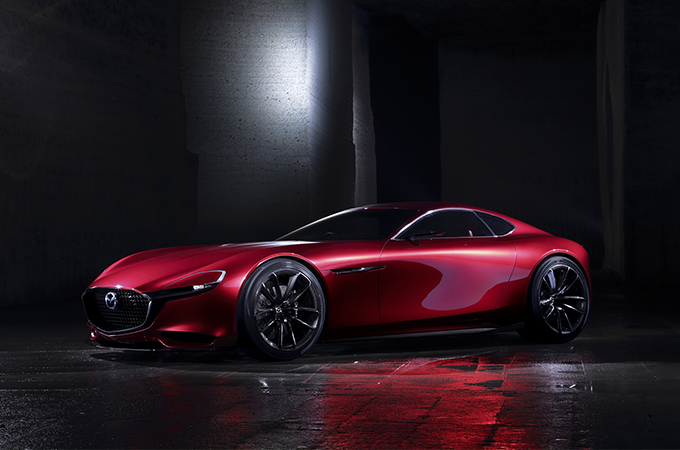
Learning about the “spirit of monozukuri” from a car designer currently active in the profession would be of tremendous value to students. As that active car designer, what do you think are the qualities that society needs in working people?
Maeda: That would be “people who can be aware that they are professionals.” I think that being a professional means being able to take responsibility for one’s own output. I want people to be able to approach their work, not with the attitude that they are doing it because someone else told them to, but because of their own strong conviction that, ‘This is what I think and I won’t be swayed.” It doesn’t matter if what they think seems immature; I want them to have that conviction. At the risk of exaggerating, I love people who are able to stake their lives on what they are making, people who are intense and forceful. If a person has passion, then it doesn’t matter how much he or she knows. On the other hand, I don’t need people who are cool, passive and only concerned with staying in balance with those around them. Once, after I’d given a lecture at Kyoto Institute of Technology, a student came up to me and said, “I seriously want to make things.” That young man is now working as an engineer at Mazda. He was very serious, and it made me really happy. I think that Kyoto Institute of Technology is a wonderful place to learn that kind of artisanal ethos that won’t be swayed by markets or trends.
Finally, what innovation is Mazda aiming for going forward?
Maeda: That would be establishing our brand. We had become a company that, while it had history, it did not have tradition. I want to turn that history into “tradition.” To achieve this, my role as the General Manager of the Design Division is to lay the tracks for a “brand style” and to pass that on to the next generation. The greatest lesson I learned at Kyoto Institute of Technology is that, if you have a resolute ideology, you can create a powerful tone as a group. I want to make use of that lesson and build a brand that, no matter what part of any of our models one looks at, it will be instantly recognizable as a Mazda part.

Mazda Motor Corporation
Ikuo Maeda(Executive Officer and General Manager, Design Division, Mazda Motor Corporation)
Born in Hiroshima in 1959, he joined Mazda Motor Corporation in 1982 after graduating from Kyoto Institute of Technology. After working in advanced design and development at Yokohama Design Studio, North America Design Studio, and completing a stint at Ford’s Detroit Studio, he returned to Mazda’s headquarters design studio, where he engaged in the design and development of mass-produced vehicles. Models on which he worked as chief designer include the RX-8, and Demio (previous-generation model; Mazda 2 outside Japan). He took up his present position in 2009. As General Manager of the Design Division, he has been involved in product development, including CX-5, Atenza (Mazda 6 outside Japan), and Axela (Mazda 3 outside Japan), overseeing the design of motor shows and dealer showrooms, and other activities, and propelling forward the embodiment and communication of the “Soul of Motion” design-language. The RX-VISION rotary-engine sports concept car, which has been described as the soul of the Mazda brand, debuted in 2015.

